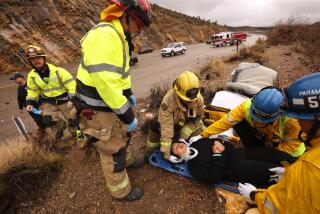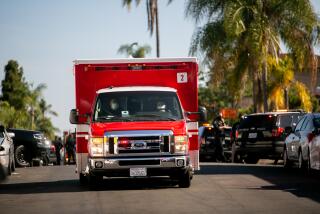Ambulances: Basic info about a service you may take for granted
Few of us expect to find ourselves riding in the back of an ambulance, yet in 2012 nearly 600,000 people in Los Angeles County were transported to hospital emergency rooms. And that’s just in response to 911 calls.
But how does it work? Where do they take you? How much does it cost and who pays for it?
Every city and county in Southern California has a slightly different way of handling emergencies. But Cathy Chidester, director of the Los Angeles County Emergency Medical Services Agency, says most local areas operate under similar principles. Here are questions and answers from her about what to expect.
What happens once someone makes a 911 call?
Los Angeles County contracts with a number of ambulance companies to provide services in most cities and county areas. Some fire departments handle their own transportation. When someone places a 911 call, the dispatcher contacts the ambulance company responsible for the zone in which the patient is located.
How long does it take an ambulance to respond to a 911 call?
Ambulances are required to arrive at their destination no more than 8 minutes and 59 seconds from the time they are dispatched by 911.
What medical personnel ride in the ambulance with the patient?
In most cases, she says, a patient will travel with one paramedic and one emergency medical technician, or EMT, unless his or her condition is critical, in which case two paramedics will ride in the ambulance.
Trained in basic life support techniques, such as first aid and CPR, EMTs are “mostly monitoring the patients,” she says.
Paramedics are able to perform a wider range of medical procedures, such as inserting an IV and administering treatments to open a person’s airways. They can also administer a limited list of medications, such as those used to treat pain or a severe allergic reaction, or to save someone suffering a drug overdose.
How do ambulance personnel decide which hospital to deliver the patient to?
As with other counties nationwide, Los Angeles ambulances go to the closest hospital best geared for the treatment being sought. “Not each hospital is created equal for emergency care,” she says.
There are 72 hospitals in L.A. County approved to receive patients traveling by ambulance in response to a 911 call. These hospitals are categorized by Chidester’s department based on where and whether they fit into one of four areas of clinical need.
Accident victims are taken to hospitals best suited to treat trauma. Other patients go to designated hospitals that treat stroke victims, heart attacks and children. Cases that don’t fall into any of these four areas are taken to the closest hospital with a licensed emergency room.
“These are all hospitals that have agreements with us and have committed that they would provide a certain level of care and education to their staff and have specific equipment available,” she says.
So, for example, if you’re having chest pain, the paramedics will take you to the nearest hospital with the equipment, expertise and facilities to treat heart attack patients, even if there’s another hospital closer by. This policy improves the patient’s odds of survival and leads to better results, she says.
But what if I want to go to a different hospital?
You do have the right to request a particular hospital. If it won’t jeopardize your condition, the paramedics can honor your request to be taken to the hospital of your choice — as long as it does not take them too far out of their service area.
However, if the paramedics believe it will put you in danger, they will stand firm. Patients can still insist, at which point they’ll need to sign a waiver stating they demand to be taken to a particular hospital against medical advice. But Chidester says: “I wouldn’t advise that.”
What is the average cost of an ambulance ride?
In Los Angeles, basic emergency ambulance transport is about $1,000 to $1,100. The cost is more like $1,200 to $1,300 for a transport that requires advanced life support. Included is the cost for paramedics and the ambulance ride itself. However, companies can charge extra for mileage, supplies and equipment.
Both Medicare and private insurance generally cover the cost of ambulance rides — as long as they are deemed medically necessary. Medicare pays 80% of an approved amount and patients pay the remaining 20%. Private health plans must cover emergency care, which includes ambulance transportation. But exactly how much is covered differs among policies.
Is there anything I can do ahead of time?
Chidester says that although we can’t anticipate emergencies, we can prepare for them. It’s not a bad idea, she says, to know in advance which area hospitals participate with your insurance plan so that you can direct the ambulance to an in-network facility, if you’re in the state of mind to do so.
In addition, she suggested that people consider ways to keep handy their medical information. For instance, she mentioned smartphone apps, such as the ICEBlueButton. It allows you to create an emergency record containing your medical information and emergency contacts. The app will generate a code that paramedics can scan to quickly learn about your health conditions, allergies, what medications you take, as well as who your doctor is and what insurance you have.
“I would like to see people have their basic information available for the paramedics,” she says. “That would go a long way toward helping them save lives.”
Zamosky is the author of a new book, “Healthcare, Insurance, and You: The Savvy Consumer’s Guide.”
More to Read
Inside the business of entertainment
The Wide Shot brings you news, analysis and insights on everything from streaming wars to production — and what it all means for the future.
You may occasionally receive promotional content from the Los Angeles Times.










